General Sir John Monash, Personal Files Book 17, 14 January - 11 February 1918, Part 2
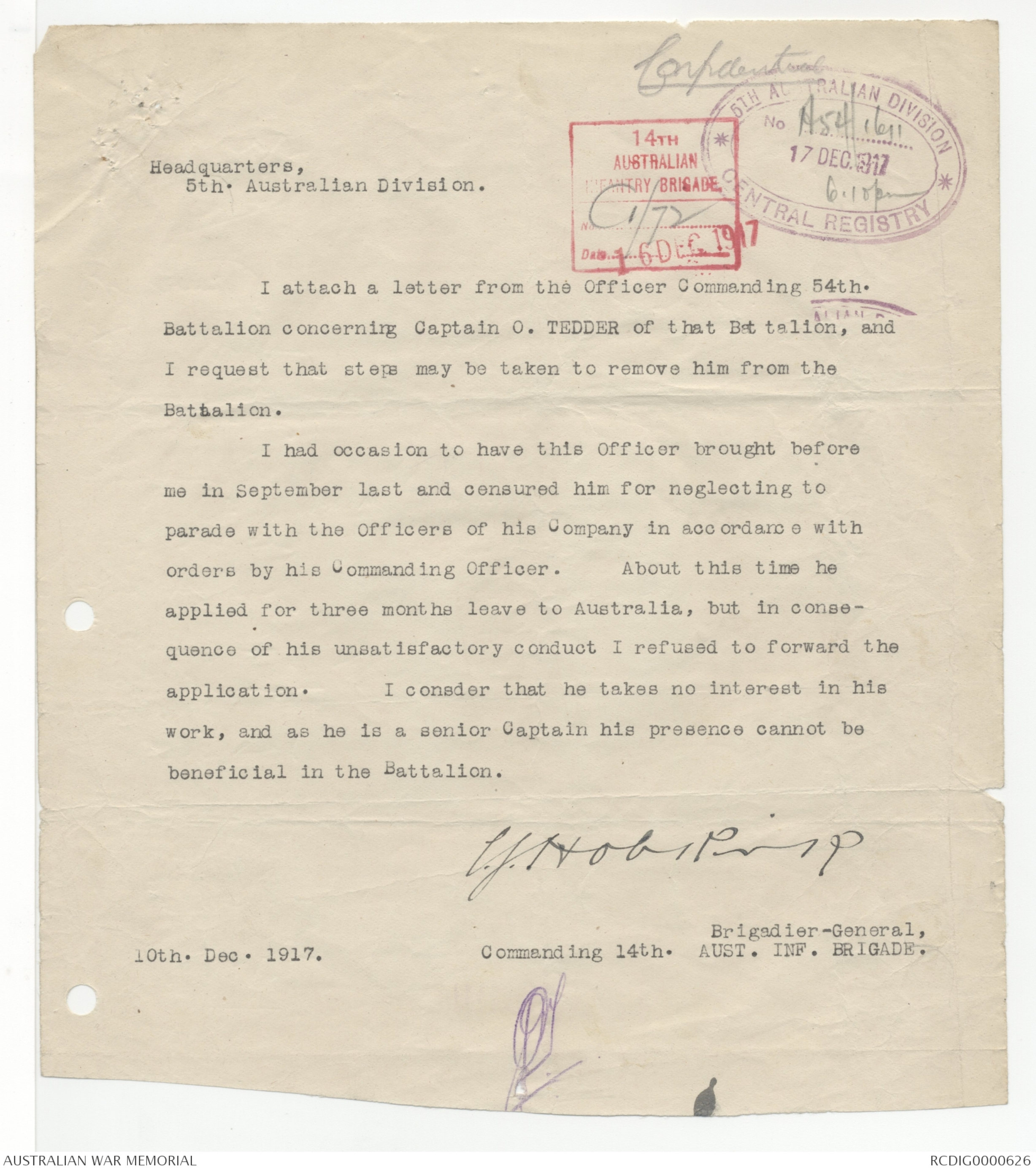
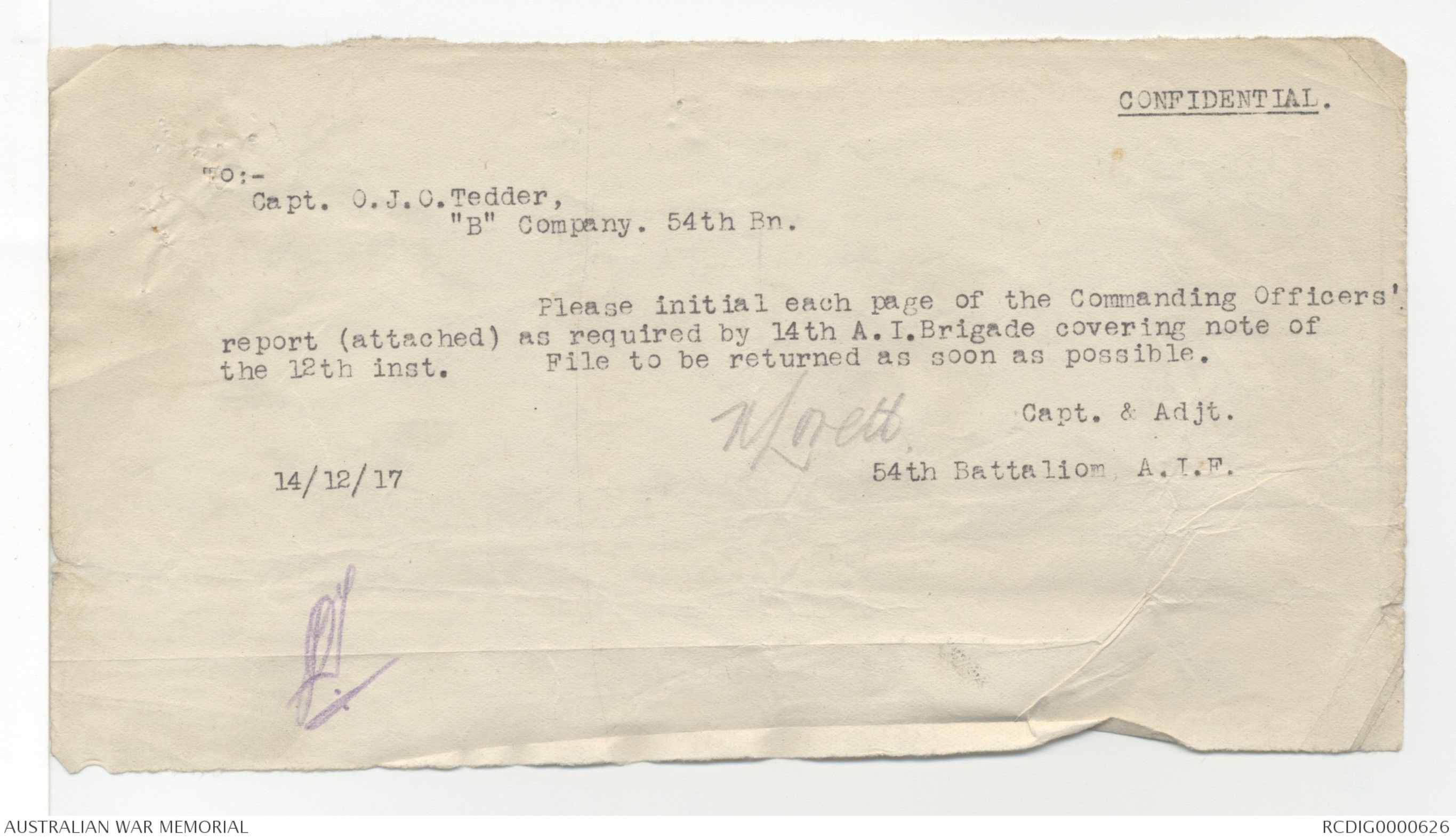
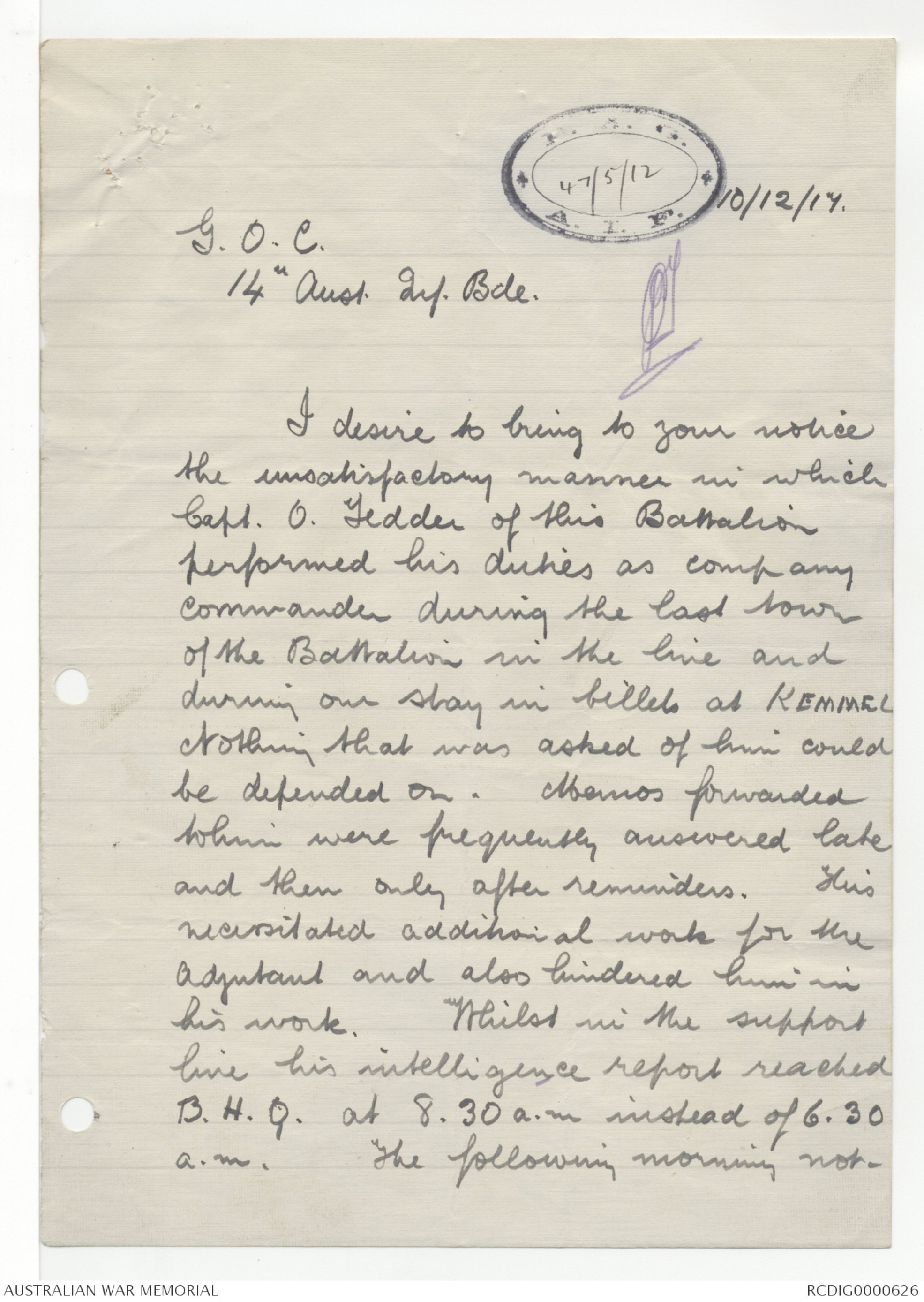

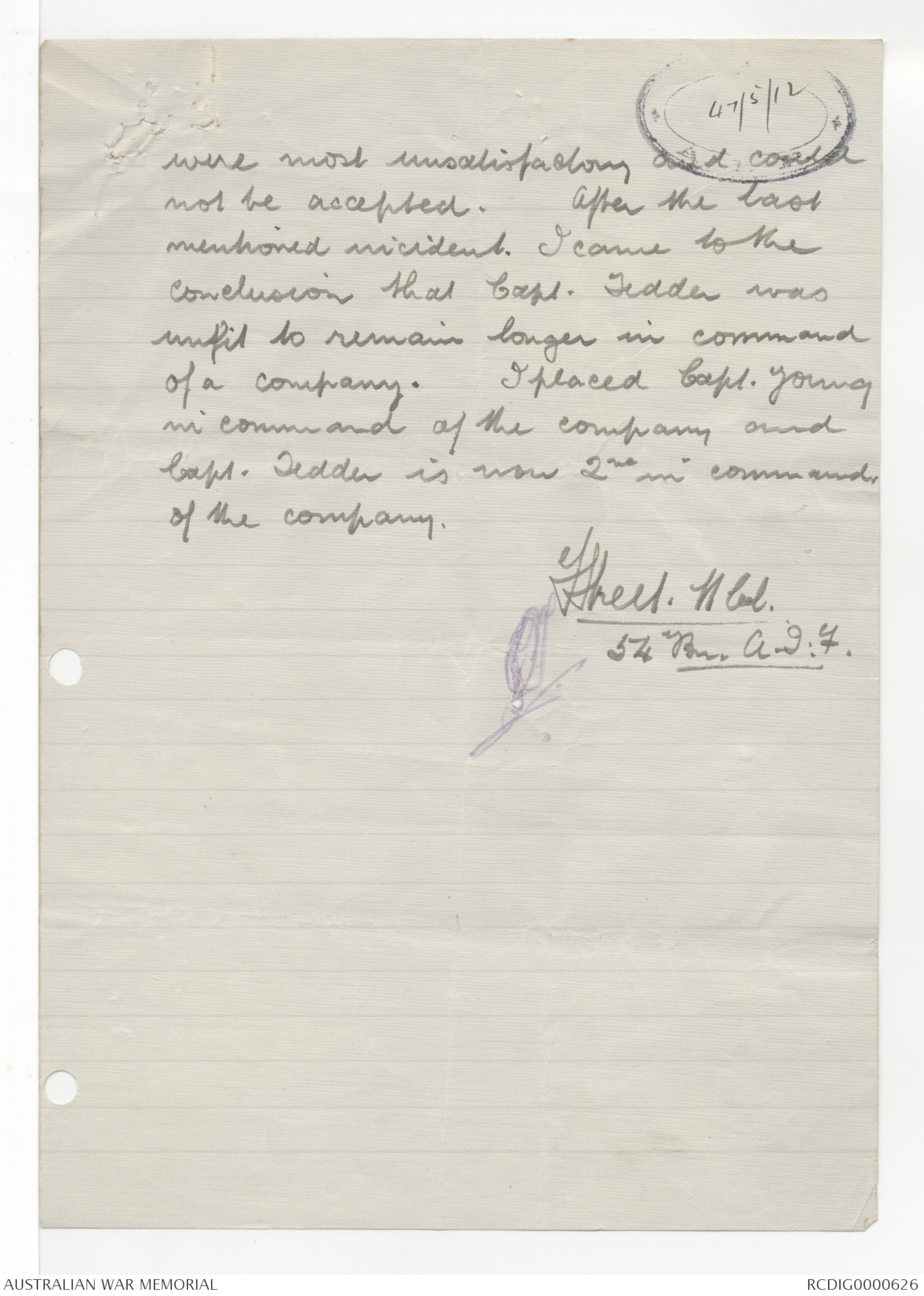
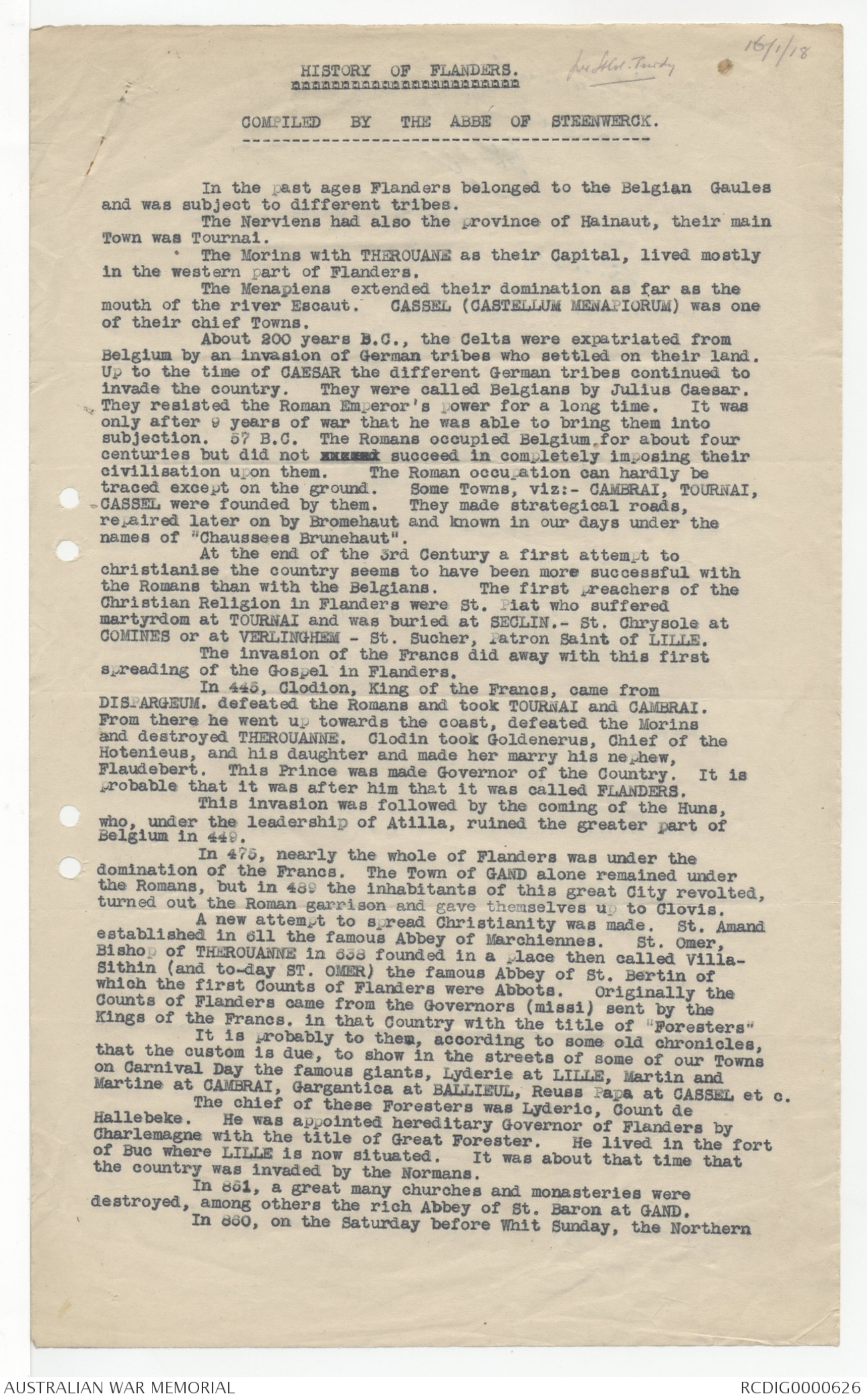
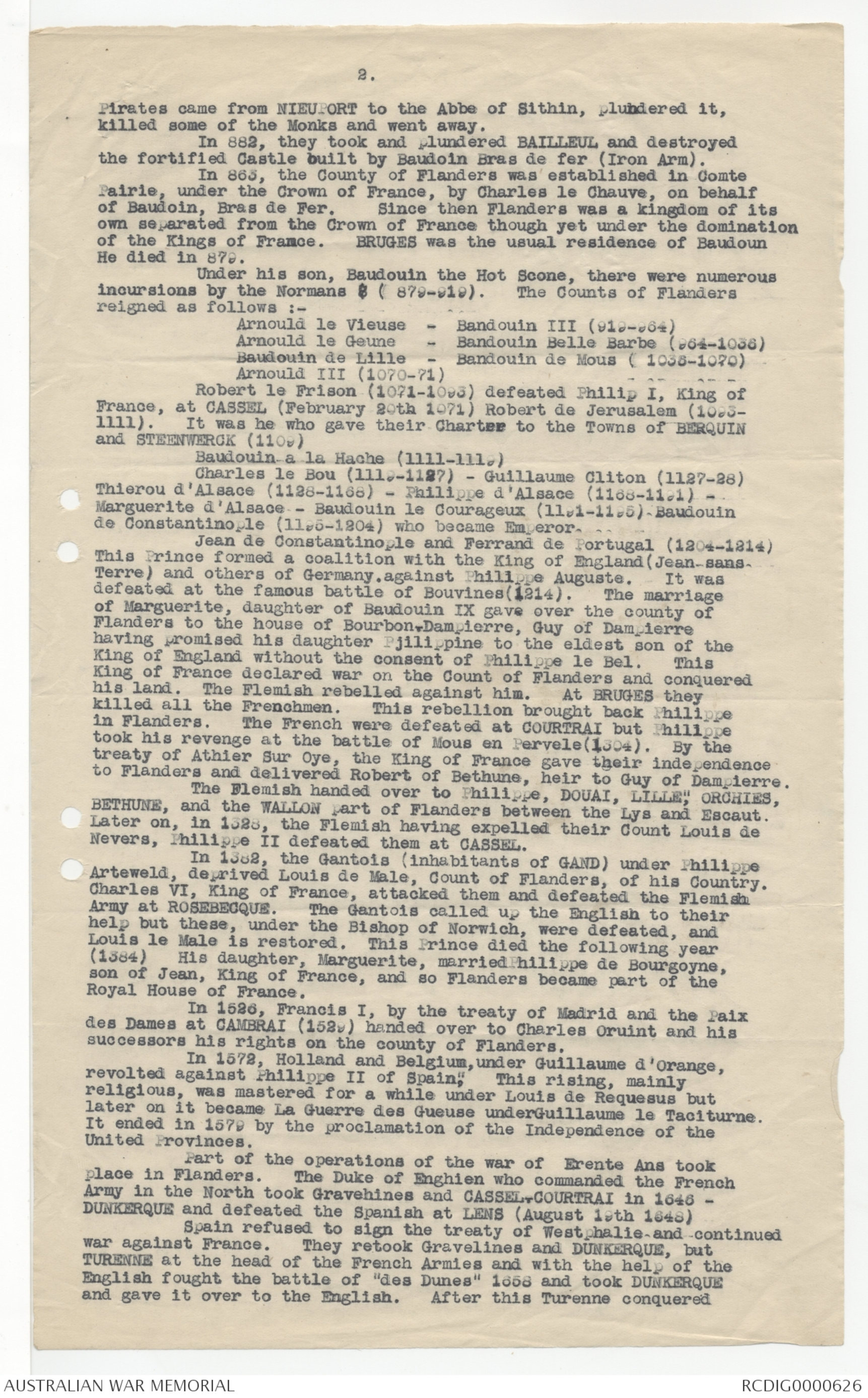
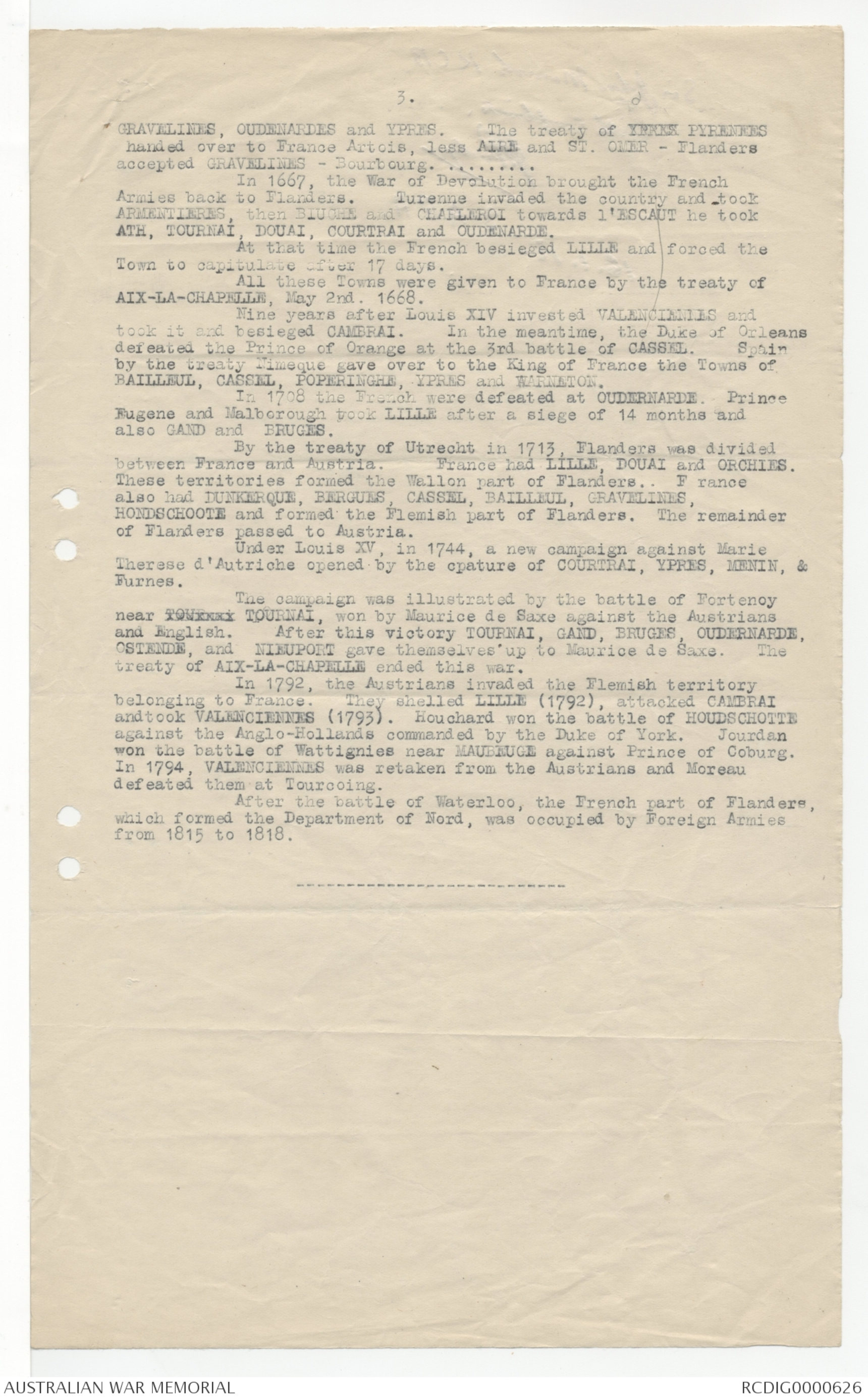
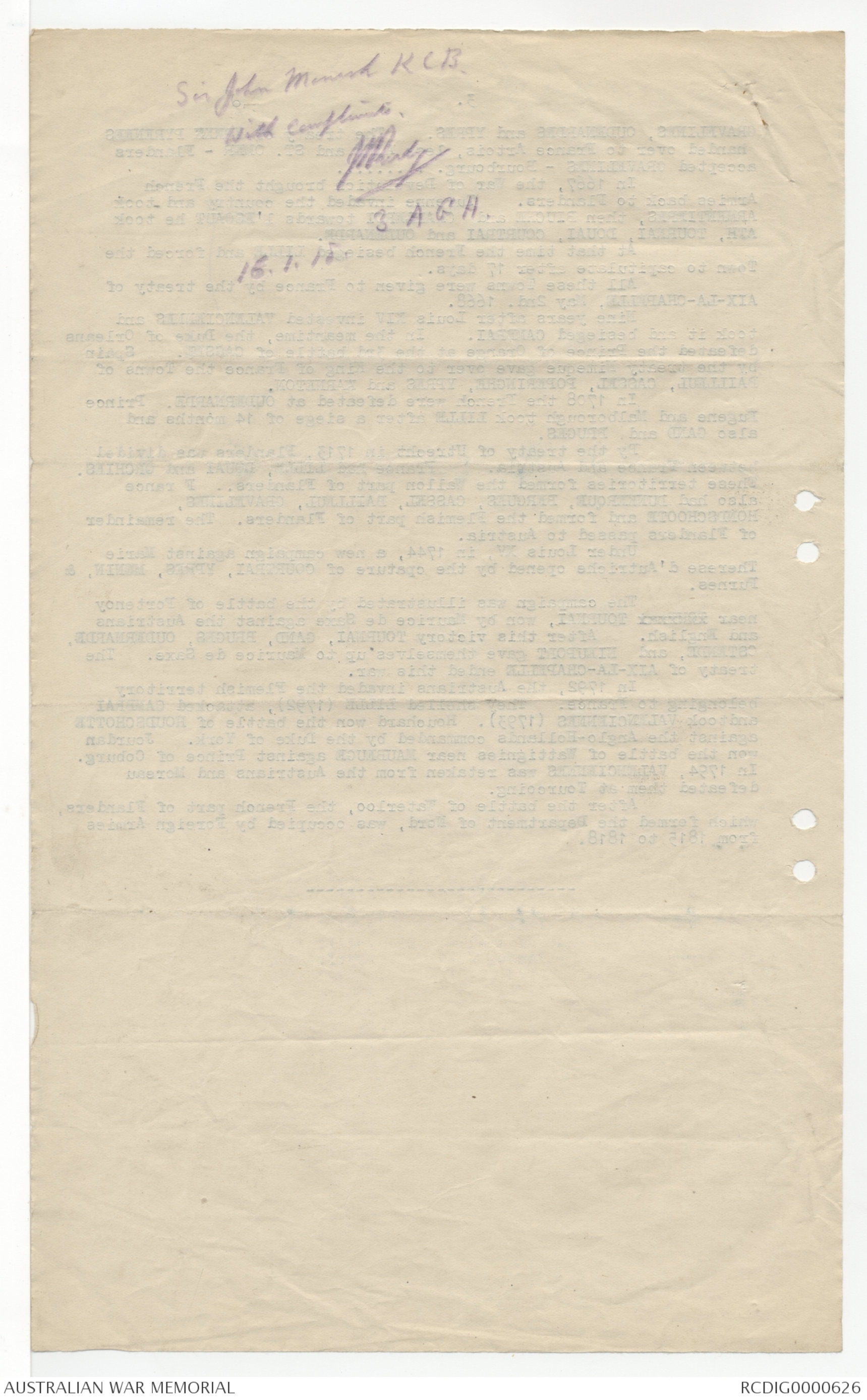
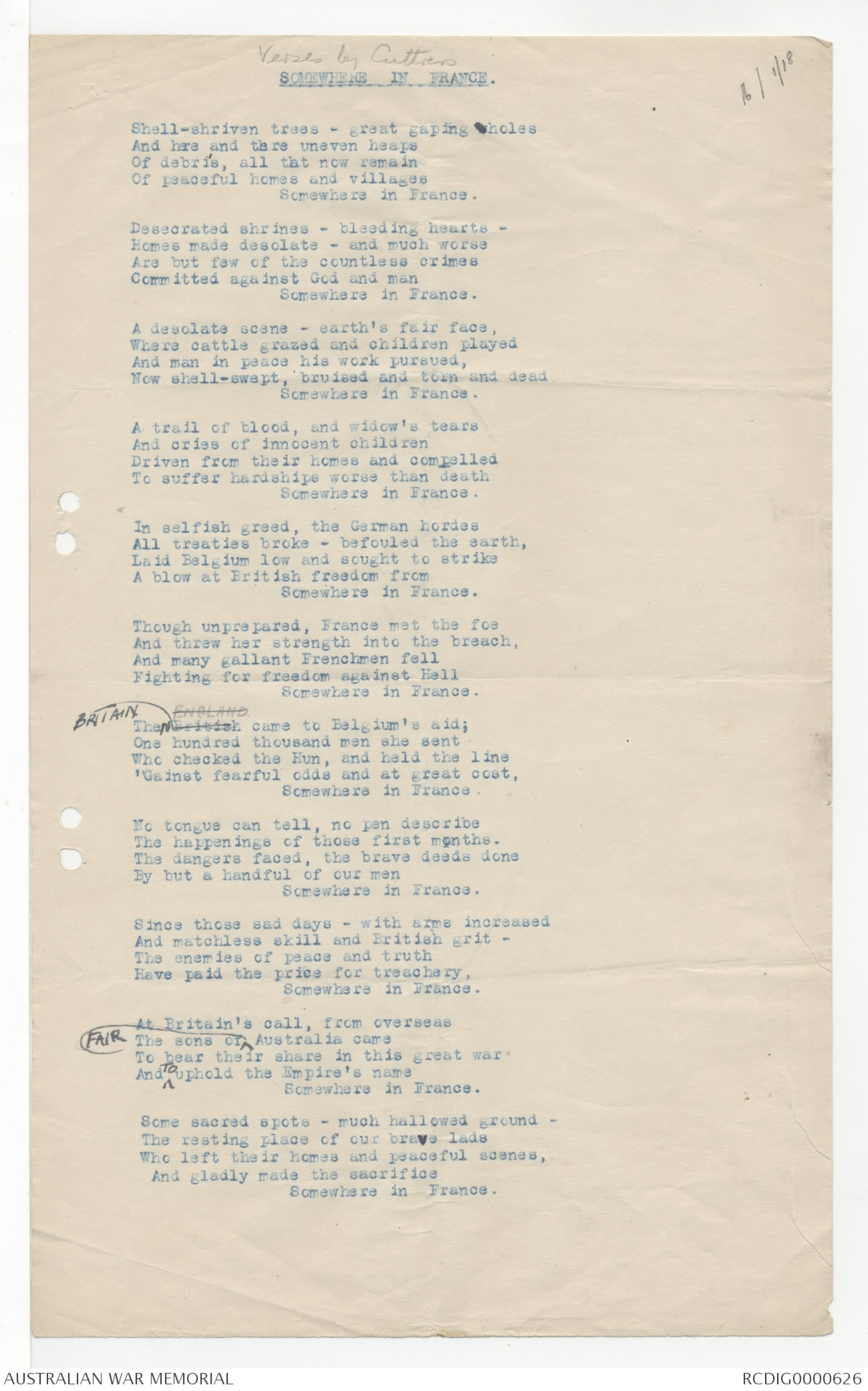
Confidential
5th AUSTRALIAN DIVISION
No A 54/1611
17 DEC/ 1917
6.10 pm
CENTRAL REGISTRY
14TH
AUSTRALIAN
INFANTRY BRIGADE.
No C1/72
Date 16 DEC 1917
Headquarters,
5th. Australian Division.
I attach a letter from the Officer Commanding 54th.
Battalion concerning Captain O. TEDDER of that Battalion, and
I request that steps may be taken to remove him from the
Battalion.
I had occasion to have this Officer brought before
me in September last and censured him for neglecting to
parade with the Officers of his Company in accordance with
orders by his Commanding Officer. About this time he
applied for three months leave to Australia, but in consequence
of his unsatisfactory conduct I refused to forward the
application. I consider that he takes no interest in his
work, and as he is a senior Captain his presence cannot be
beneficial in the Battalion.
C.J Hobkirk
Brigadier-General,
Commanding 14th. AUST. INF. BRIGADE.
10th. Dec. 1917.
OJT
CONFIDENTIAL.
TO:-
Capt. O.J.O. Tedder,
"B" Company. 54th Bn.
Please initial each page of the Commanding Officers'
report (attached) as required by 14th A.I. Brigade covering note of
the 12th inst. File to be returned as soon as possible.
N Lorett. Capt. & Adjt.
54th Battalion, A.I.F.
14/12/17
OJT
47/5/12
A.I.F. 10/12/17.
G.O.C.
14th Aust Inf. Bde.
[*OJT*]
I desire to bring to your notice
the unsatisfactory manner in which
Capt. O. Tedder of this Battalion
performed his duties as company
commander during the last tour
of the Battalion in the line and
during our stay in billets at KEMMEL
Nothing that was asked of him could
be depended on. Memos forwarded
to him were frequently answered late
and then only after reminders. This
necessitated additional work for the
adjutant and also hindered him in
his work. Whilst in the support
line his intelligence report reached
B.H.Q. at 8.30 a.m instead of 6.30
a.m. The following morning not- withstanding
47/5/12 OJT
A.I.F.
that I spoke personally
to him about the matter and impressed
upon him the importance of
intelligence reports. The report was
again late. When in the front
line his intelligence report was
so scanty as to be useless to the
Intelligence Officer. When we
came out of the line he took upon
himself to alter my lines of parades
without consulting me and in consequence
when I went along to see
his company they were just getting
out of bed. Then again a party
was detailed to be found from his
company of which he had had timely
warning. The party was half an
hour late in reporting and so
kept the rest of the battalion waiting.
I had spoken to him about these
several matters before the last
mentioned incident and his excuses
47/5/12
A.I.F.
were most unsatisfactory and could
not be accepted. After the last
mentioned incident, I came to the
conclusion that Capt. Tedder was
unfit to remain longer in command
of a company. I placed Capt. Young
in command of the company and
Capt. Tedder is now 2nd in command
of the company.
F Street. Lt Col.
54th Bn A.I.F.
OJT
[*16/1/18
for LtCol. Purdy*]
HISTORY OF FLANDERS
COMPILED BY THE ABBE OF STEENWERCK.
In the past ages Flanders belonged to the Belgian Gaules
and was subject to different tribes.
The Nerviens had also the province of Hainaut, their main
Town was Tournai.
The Morins with THEROUANE as their Capital, lived mostly
in the western part of Flanders.
The Menapiens extended their domination as far as the
mouth of the river Escaut. CASSEL (CASTELLUM MENAPIORUM) was one
of their chief Towns.
About 200 years B.C., the Celts were expatriated from
Belgium by an invasion of German tribes who settled on their land.
Up to the time of CAESAR the different German tribes continued to
invade the country. They were called Belgians by Julius Caesar.
They resisted the Roman Emperor's power for a long time. It was
only after 9 years of war that he was able to bring them into
subjection. 57 B.C. The Romans occupied Belgium for about four
centuries but did not xxxxxx succeed in completely imposing their
civilisation upon them. The Roman occupation can hardly be
traced except on the ground. Some Towns, viz:- CAMBRAI, TOURNAI,
CASSEL, were founded by them. They made strategical roads,
repaired later on by Bromehaut and known in our days under the
names of "Chaussees Brunehaut".
At the end of the 3rd Century a first attempt to
christianise the country seems to have been more successful with
the Romans than with the Belgians. The first preachers of the
Christian Religion in Flanders were St. Piat who suffered
martyrdom at TOURNAI and was buried at SECLIN. - St. Chrysole at
COMINES or at VERLINGHEM - St. Sucher, Patron Saint of LILLE.
The invasion of the Francs did away with this first
spreading of the Gospel in Flanders.
In 445, Clodion, King of the Francs, came from
DISPARGEUM. defeated the Romans and took TOURNAI and CAMBRAI.
From there he went up towards the coast, defeated the Morins
and destroyed THEROUANNE. Clodin took Goldenerus, Chief of the
Hotenieus, and his daughter and made her marry his nephew,
Flaudebert. This Prince was made Governor of the Country. It is
probable that it was after him that it was called FLANDERS.
This invasion was followed by the coming to the Huns,
who, under the leadership of Atilla, ruined the greater part of
Belgium in 449.
In 475, nearly the whole of Flanders was under the
domination of the Francs. The Town of GAND alone remained under
the Romans, but in 489 the inhabitants of this great City revolted,
turned out the Roman garrison and gave themselves up to Clovis.
A new attempt to spread Christianity was made. St. Amand
established in 611 the famous Abbey of Marchiennes. St. Omer,
Bishop of THEROUANNE in 638 founded in a place then called Villa-Sithin
(and to-day ST. OMER) the famous Abbey of St. Bertin of
which the first Counts of Flanders were Abbots. Originally the
Kings of the Francs, in that Country with the title of "Foresters"
It is probably to them, according to some old chronicles,
on Carnival Day the famous giants, Lyderie at LILLE, Martin and
Martine at CAMBRAI, Gargantica at BALLIEUL, Reuss Papa at CASSEL et c.
The chief of these Foresters was Lyderic, Count de
Hallebeke. He was appointed hereditary Governor of Flanders by
Charlemagne with the title of Great Forester. He lived in the fort
of Buc where LILLE is now situated. It was about that time that
the country was invaded by the Normans.
In 851, a great many churches and monasteries were
destroyed, among others the rich Abby of St. Baron at GAND.
In 860, on the Saturday before Whit Sunday, the Northern
2.
Pirates came from NIEUPORT to the Abbe of Sithin, plundered it,
killed some of the Monks and went away.
In 882, they took and plundered BAILLEUL and destroyed
the fortified Castle built by Boudoin Bras de fer (Iron Arm).
In 863, the County of Flanders was established in Comte
Pairie, under the Crown of France, Charles le Chauve, on behalf
of Baudoin, Bras de Fer. Since then Flanders was a kingdom of its
own separated from the Crown of France though yet under the domination
of the Kings of France. Bruges was the usual residence of Baudoun
He died in 879.
Under his son, Boudouin the Hot Scone, there were numerous
incursions by the Normans 8 (879-919). The Counts of Flanders
reigned as follows :-
Arnould le Vieuse - Bandouin III (919-964)
Arnould le Geune - Bandouin Belle Barbe (964-1036)
Baudouin de Lille - Bandouin de Mous (1036-1070)
Arnould III (1070-1071)
Robert le Frison (1071-1093) defeated Philip I, King of
at CASSEL (February 20th 1071) Robert de Jerusalem (1093-
1111). It was he who gave their Charter to the towns of BERQUIN
and STEENWERCK (1109)
Baudouin a la Hache (1111-1119)
Charles le Bou (1119-1127) - Gillaume Cliton (1127-28)
Thierou d'Alsace - Baudouin le Courageux (1191-1195). Baudouin
de Constantinople (1195-1204) who became Emperor.
Jean de Constantinople and Ferrand de Portugal (1204-1214)
This Prince formed a coalition with the King of England (Jean-sans-Terre)
and others of Germany. against Philippe Auguste. It was
defeated at the famous battle of Bouvines (1214). The marriage
of Margurite, daughter of Baudouin IX gave over the county of
Flanders to the house of Bourbon-Dampierre, Guy of Dampierre
having promised his daughter Pjilippine to the eldest son of the
King of England without the consent of Philippe le Bel. This
King of France declared war on the Count of Flanders and conquered
his land. The Flemish rebelled against him. At BRUGES they
killed all the Frenchmen. This rebellion brought back Philippe
in Flanders. The French were defeated at COURTRAI but Philippe
took his revenge at the battle of Mous en Pervele(1304). By the
treaty of Athier Sur Oye, the King of France gave their independence
to Flanders and delivered Robert of Bethune, heir to Guy of Dampierre.
The Flemish handed over to Philippe, DOUAI, LILLE," ORCHIES,
BETHUNE, and the WALLON part of Flanders between the Lys and Escaut.
Later on, in 1328, the Flemish having expelled their Count Louis de
Nevers, Philippe II defeated them at CASSEL.
In 1382 the Gantois (inhabitants of GAND) under Philippe
Arteweld, deprived Louis de Male, count of Flanders, of his Country.
Charles VI, King of France, attacked them and defeated the Flemish
Army at ROSEBECQUE. The Gantois called up the English to their
help but these, under the Bishop of Norwich, were defeated, and
Louis le Male is restored. This Prince died the following year
(1384) His daughter, Marguerite, married Philippe de Bourgoyne,
son of Jean, King of France, and so Flanders became part of the
Royal House of France.
In 1526, Francis I, by the treaty of Madrid and the Paix
des Dames at CAMBRAI (1529) handed over to Charles Oruint and his
successors his rights on the county of Flanders.
In 1572, Holland and Belgium, under Guillaume d'Orange,
revolted against Philippe II of Spain." This rising, mainly
religious, was mastered for a while under Louis de Requesus but
later on it became La Guerre des Gueuse underGuillaume le Taciturne.
It ended in 1579 by the proclamation of the Independence of the
United Provinces.
Part of the operations of the war of Erente Ans took
place in Flanders. The Duke of Enghien who commanded the French
Army in the North took Gravehines and CASSEL-COURTRAI in 1646-
DUNKERQUE and defeated the Spanish at LENS (August 19th 1648)
Spain refused to sign the treaty of Westphalie-and-continued
war against France. They retook Gravelines and DUNKERQUE, but
TURENNE at the head of the French Armies and with the help of the
English fought the battle of "des Dunes" 1658 and took DUNKERQUE
and gave it over to the English. After this Turenne conquered
3.
GRAVELINES, OUDENARDES and YPRES. The treaty of YPRES PYRENEES
handed over to France Artois, Less AIRE and ST. OMER - Flanders
accepted GRAVELINES - Bourbourg. ....................
In 1667, the War of Devolution brought the French
Armies back to Flanders. Turenne invaded the country and took
ARMENTIERES, then BIUCHE and CHARLEROI towards l'ESCAUT he took
ATH, TOURNAI, DOUAI, COURTRAI and OUDENARDE.
At that time the French besieged LILLE and forced the
Town to capitulate after 17 days.
All these Towns were given to France by the treaty of
AIX-LA-CHAPELLE, May 2nd. 1668.
Nine years after Louis XIV invested VALENCANNES and
took it and besieged CAMBRAI. In the meantime, the Duke of Orleans
defeated the Prince of Orange at the 3rd battle of CASSEL. Spain
by the treaty Nimeque gave over to the King of France the Towns of
BAILLEUL, CASSEL, POPERINGHE, YPRES and WARNETON.
In 1708 the French were defeated at OUDERNARDE. Prince
Eugene and Marlborough to LILLE after a siege of 14 months and
also GAND and BRUGES.
By the treaty of Utrecht in 1713, Flanders was divided
between France and Austria. France had LILLE, DOUAI and ORCHIES.
These territories formed the Wallon part of Flanders. France
also had DUNKERQUE, BERGUES, CASSEL, BAILLEUL, GRAVELINES,
HONDSCHOOTE and formed the Flemish part of Flanders. The remainder
of Flanders passed to Austria.
Under Louis XV, in 1744, a new campaign against Marie
Therese d'Austriche opened be the capture of COURTRAI, YPRES, MENIN, &
Furnes.
The campaign was illustrated by the battle of Fortency
near TOURxx TOURNAI, won by Maurice de Saxe against the Austrians
and English. After this victory TOURNAI, GAND, BRUGES, OUDERNARDE,
OSTENDE, and NIEUPORT gave themselves up to Maurice de Saxe. The
treaty of AIX-LA-CHAELLE ended this war.
In 1792, the Austrians invaded the Flemish territory
belonging to France. They shelled LILLE (1792), attacked CAMBRAI
and took VALENCIENNES (1793). Houchard won the battle of
HOUDSCHOTTE
against the Anglo-Hollands commanded by the Duke of York. Jourdan
won the battle of Wattignies near MAUREUGE against Prince of Coburg.
In 1794, VALENCIENNES was retaken from the Austrians and Moreau
defeated them at Tourcoing.
After the battle of Waterloo, the French part of Flanders,
which formed the Department of Nord, was occupied by Foreign Armies
from 1815 to 1818.
Sir John Monash KCB.
with compliments
JV Reidy
3 AGH.
16/1/18
Verses by Cuttress
SOMEWHERE IN FRANCE.
16/1/18
Shell-shriven trees - great gaping wholes
And here and there uneven heaps
Of debris, all that now remain
Of peaceful homes and villages
Somewhere in France.
Desecrated shrines - bleeding hearts -
Homes made desolate - and much worse
Are but few of the countless crimes
committed against God and Man
Somewhere in France.
A desolate scene - earth's fair face,
Where cattle grazed and children played
And man in peace his work pursued,
Now shell-swept, bruised and torn and dead
Somewhere in France.
A rail of blood, and widow's tears
And cries on innocent children
Driven from their homes and compelled
To suffer hardships worse that death
Somewhere in France.
In selfish greed, the German hordes
All treaties broke - befouled the earth,
Laid Belgium low and sought to strike
A blow at British freedom from
Somewhere in France.
Tough unprepared, France met the foe
And threw her strength into the breach,
And many gallant Frenchmen fell
Fighting for freedom against Hell
Somewhere in France.
Then British England BRITAIN came to Belgium's aid;
One hundred thousand men she sent
Who checked the Hun, and held the line
'Gainst fearful odds and at great cost,
Somewhere in France.
No tongue can tell, no pen describe
The happening of those first months.
The dangers faced, the brave deeds done
By but a handful of our men
Somewhere in France.
Since those sad days - with arms increased
And matchless skill and British grit -
The enemies of peace and truth
Have paid the price for treachery,
Somewhere in France.
At Britain's call, from overseas
The sons of ^FAIR Australia came
To bear their share in this great war
and ^TO uphold the Empire's name
Somewhere in France.
Some sacred spots - much hallowed ground -
The resting place of our brave lads
Who left their homes and peaceful scenes,
And gladly made the sacrifice
Somewhere in France.
 Sam scott
Sam scottThis transcription item is now locked to you for editing. To release the lock either Save your changes or Cancel.
This lock will be automatically released after 60 minutes of inactivity.